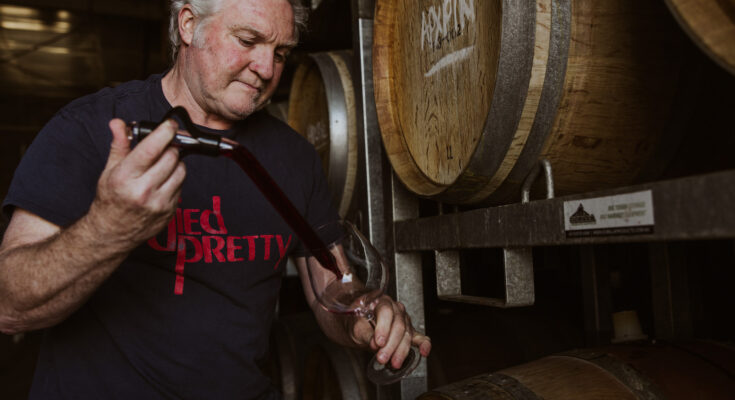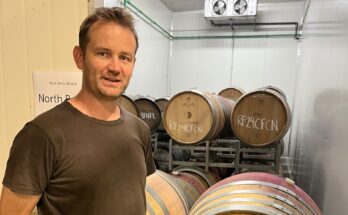In the days before I arrived in the Yarra Valley, one winery from the area received an award from ‘The Real Review’ as their ‘Winery of the Year’. As one of the most celebrated places in the region – Oakridge is also often mentioned in Hallidays Wine Companion (and indeed is listed in the Runners Up section of the 2022 guide). Also in that guide, winemaker Dave Bicknell receives over twenty scores of 93/100+ for the Oakridge wines. It’s no surprise then that a visit is pencilled in for Day 1 of the trip…
Dave Bicknell: I’m glad you’re here on a dry, sunny day. The last week in March and the first days of April – in twenty days we had thirteen of those as rain days. It’s just been an absolute struggle to get some things over the line.
WineFolio: I get a sense from what I’ve read that you’re a football fan.. but how does being a big football fan tie into making wine in Yarra Valley?
DB: It doesn’t. One thing I certainly can’t do is play football any longer. I played well into my late 40’s, but everything hurts now. When we came to Melbourne in 1974 we had no family in the country. I was supposed to go to sea. My father was a Ship’s Captain, Master Mariner; and so was his twin brother – and going back another five generations before that. So they were born and bred in Leith, Edinburgh; and went to sea during the Second World War. Dad spent a lot of time on the trade route from England to the US and down to Argentina. He developed a taste for wine. So when we growing up as kids there was always wine on the table. When we moved out here there was more wine on the table because it was so good and so cheap!
After I finished school, a mate of mine who came from Rutherglen told me about a course where you could go and study wine. I said “You’re kidding – you can study this? That’s what I’m going to do!” So I went to Roseworthy and that’s where a lot of the connections are from. Tom Carson, Matt Harrop who’s up at Curly Flat – we’re a very tight group – and Steve Flamsteed and I shared a house together for three years. All our kids have grown up together.
I worked for the De Bortoli family for ten years. I started there in 1992. Actually Brian Fletcher had offered me a job at St. Huberts, before SouthCorp bought it. We were students – a group of four of us – and we said we’d go up to De Bortoli and see what’s going on. There were a few characters in common and they said “come back here and work”. I’m not sure things are the same now, as the industry has grown enormously.
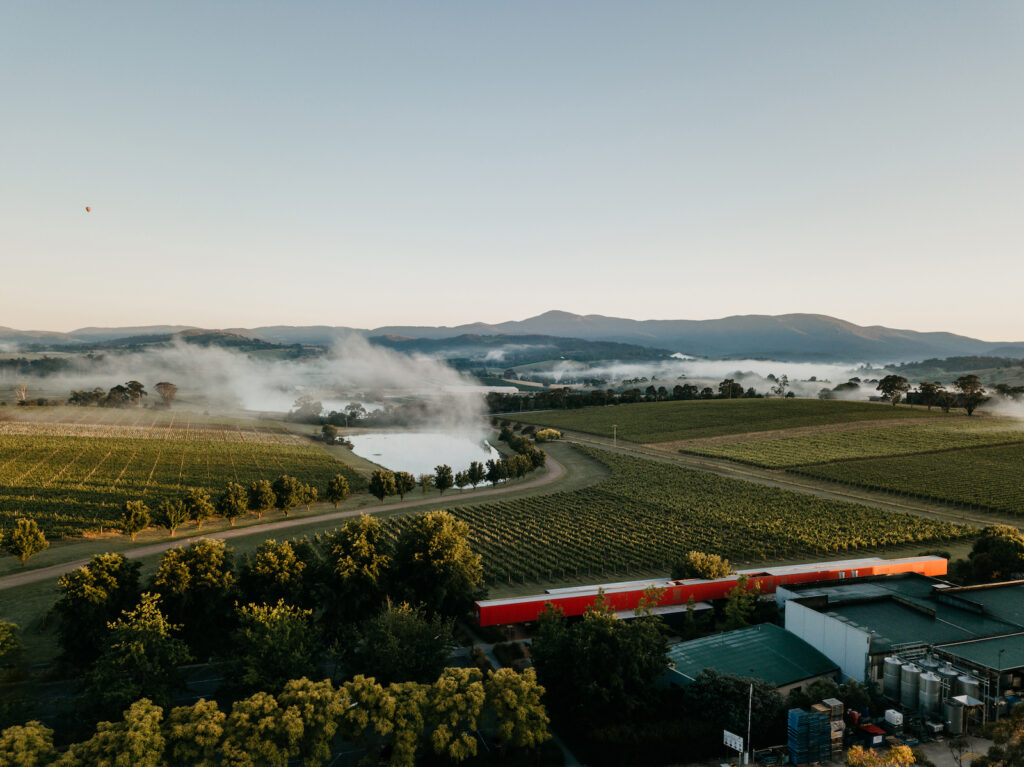
WF: Is there anything that you don’t like now, about how the industry has changed?
DB: The reliance on Marketing and Commerce now. Doing deals. It’s a lot harder and it’s a lot bigger, and a lot of it is about connections more than anything else. It’s not quite as friendly, I think as it used to be – because it is bigger. But the next round of kids that are coming through, and I’ve had a bit to do with a whole group of them, and they’re fantastic. They’ve got the idea that it is about quality – no.1 – rather than anything else. And I think that’s important. So there’s a whole group who I think are probably a bit more like we were. Where we just push each other.
WF: I was reading that Young Guns of wine website and awards thing before I came over.
DB: And there’s the obsession with youth, as opposed to experience…
WF: Ah yes, the Cult of Youth! In New Zealand we had a Prime Minister who was the world’s youngest elected Head of Government at 37. What kind of life experience is that, to be leading an entire country? But, I’m not going onto politics…
But does Yarra have that ‘next steps’ stage of evolution ahead of it – and perhaps the next generation are the ones to take on that challenge – of the sub-regional conversation? I watched an interview with Mac Forbes last month where he alluded to that, and talked about how Yarra is seen as this one big place, but really it is lots of small places and he was going to have his Villages label to reflect that?
DB: Well Mac and I differ on views on this. Yering Station and Deborts do that with their labelling as well. The things with the Yarra is that because there’s nothing homogeneous – the only homogeneous part of the valley is probably here in front of the Warramate Hills. You go from Giant Steps, Yarra Yering, Dominique Portet and Medhurst – then us and Yeringberg, St Huberts and Mount Mary. There’s a lineup there! It’s a small section where pretty much all the good Cabernet in the valley comes from.
Everyone talks about the Yarra with Chardonnay and Pinot, but arguably the three most important wines in the Valley are still Cab! Mount Mary, Yarra Yering and Yeringberg. Even with Oakridge – we’re in the zone but we’ve been pigeonholed as a white wine producer. We like our Chardonnay, but we put the same amount of attention into all the wines we make. We’ve landed in the spot where we’re able to do this effortlessly because we’re growing it in the right place in the valley. And that’s the key to it.
The sub-regions has got whiskers on, because you haven’t got vineyards planted next door to each other, and often it is the signpost rather than the village. The village happens to be in Seville, or Woori Yallock or wherever it is, but there’s no real sense of homogeneous. A few hot spots. Gladysdale is a hot spot – where Willow Lake and Hazeldene are. Deer Farm, Treasury, Wombat Creek…but in fact there’s two parts to Gladysdale – there’s the Lower and Upper part! And they are quite different. Only three or four vineyards in the high part, but there’s four or five really important ones in the lower part.
Woori Yallock – again, there’s a hot spot there. But it’s not like looking at a map of Burgundy where there’s a degree of certainty – we don’t have that. And because there’s rolling hills, if you point North-east versus North-west, the result is entirely different. My argument I’ve had with Mac a number of times is that it is a collection of sites, it’s not a collection of villages. Much as you would like to make it that because it is easy to form a story.
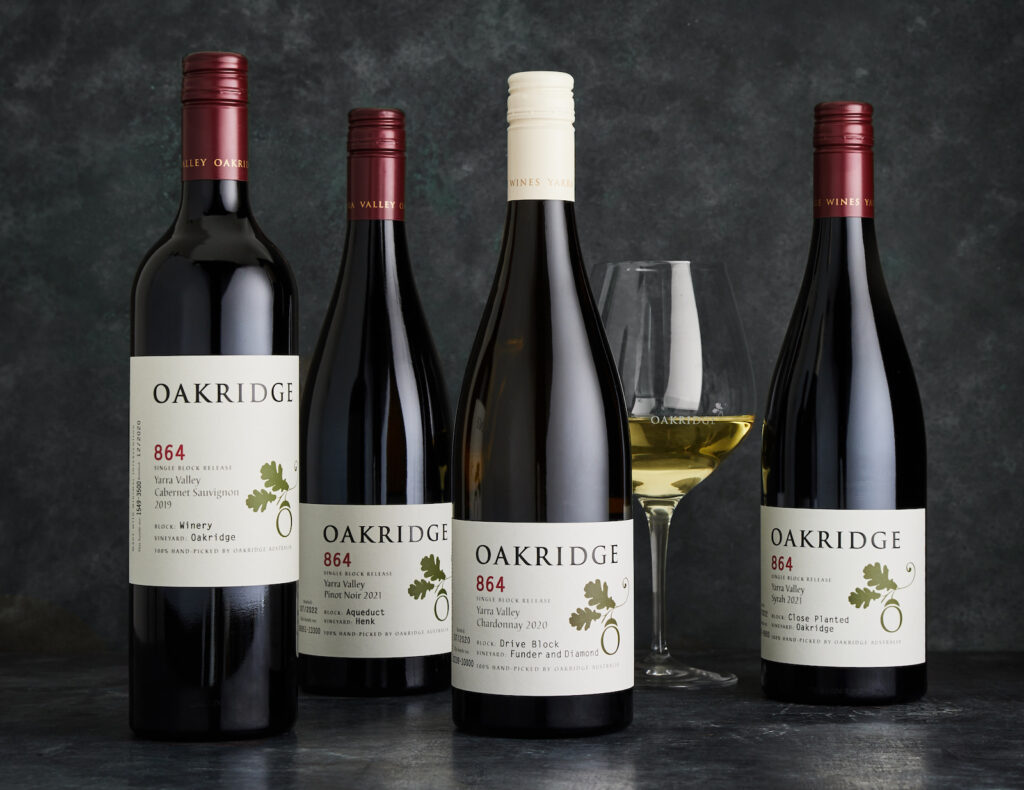
The Australian industry, particularly in the cooler regions, is still growing and learning. And there’s nothing wrong with changing your idea on how things are – or what they are…because it is changing! And the climate is changing as well. That’s had a massive impact, just on what happens in the valley. 10-15 years ago when we were up in that cooler part of the valley, we had the run of the roost. People were asking us to buy land! And now you can’t buy it for love nor money! It’s got out of control. Everyone wants to be in the same little island up at the top of the hill.
Then of course you have a season like this where everything is thrown on its head. We’ve re-engineered as much as we can in the winery to cope. We’re a one-fill winery. The 200 tonnes of red that we should get – and haven’t for four years now – we can fit it all in. In 2016 we did the entire vintage of 450 tonnes, from sparkling to Cabernet, in 23 days. You don’t take a break. Don’t look, and just go. And this year it’s been very similar – a sprint over a couple of days. The last Thursday, Friday, Saturday – just before that 65mls of rain, we did 110 tonne; to get as much in that was as close to ready as we possibly could. Manic for two or three days, and then tapered off completely. We’ve had three vintages in one. And we’re not finished. Rain is forecast next Wednesday. Even if we had seven days of this sun we’d be fine. That’s all we want.
WF: Is what you’ve learnt to do going to work for the next forty years?
DB: Dunno. We’ll probably have to make changes. Because there’s been four small vintages it is hard to get hold of fruit. If you’re not growing it yourself then you’ve got nothing. In some it’s good because the ‘virtual winemakers’ who buy a few tonnes here, there and everywhere and really disrupt business and have forced the prices up, are going. Fruit up here – Upper Yarra Chardonnay – is as expensive, if not more expensive, than Tasmanian fruit now. And of course the growers get those prices one year and they think “woo-hoo – bring on next year!” The fruit that we were buying three years ago at 1800 to 2500 a tonne is 3500-4000 now.
WF: And at Chapoutier in Heathcote, they were saying they can’t open the Cellar Door because they can’t recruit someone to stand in the showroom for $30 an hour…nobody will do it!
DB: We have to pay the pickers – unskilled labour – $36 an hour. That’s Monday to Friday. On a Public Holiday we’ve got to pay unskilled labour $66 an hour to pick frickin’ grapes! It’s insane. This year the timing has just been exquisite and there’s so many public holidays. My budget is shot to pieces. The good thing about this being a big company is that it has allowed me to not worry so much about the finances. There’s an expectation that I will keep the quality when it does come in.
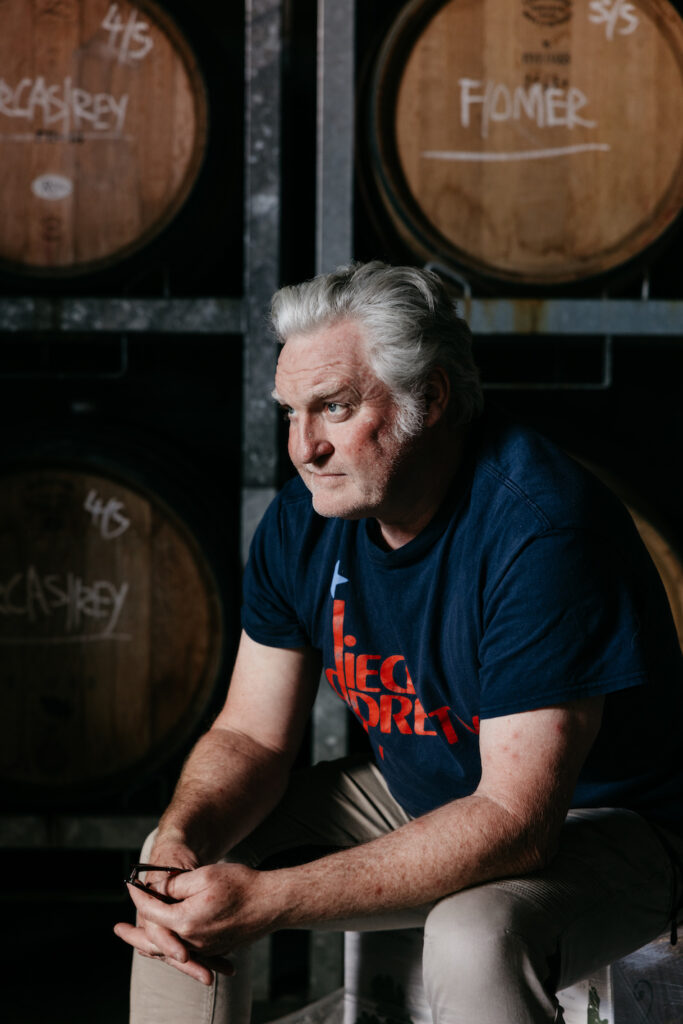
WF: And what about your own projects then? Is that under pressure?
DB: I have been doing my own label for ten years – Applecross. But the vineyard I have been managing for the last ten years fell over this year. Not one berry got picked. It doesn’t matter how long you’re in the industry and how much you know… Early downy! We were actually going along OK and there was a small-ish crop there, and we got to veraison. Then, almost like overnight, all the bunches fell off. Gone through the whole growing season with all the costs, and I went in there one morning and it’s just like “Did someone come in and pick this?” Because all the bunches were just gone! So that hurt.
WF: Do you much to do with the regional scene – are you on boards?
DB: Yes and No. I used to be a lot more involved, but I’ve stepped back from the whole thing. Sometimes it is better that you step away, than step in. I was heavily involved with the local Wine Show going back quite a few years ago because it was a basket case. It was totally embarrassing, so I helped get that back on track. So it was all set up the right way, with the right objectives. Not having any local judges so it’s an external audit. All those types of things. I get asked for an opinion on things all the time, but I’ve actually stepped off all the local committees as well. There’s a time when you realise it’s time to let someone else come through, to bring different ideas in.
We saw this in Wine Shows in this country around 15 years ago where there were three or four wine judges who were in charge of all of the Wine Shows and the results all seemed to be the same. You’d never get anywhere as a judge unless you were pals with the guys who were running these shows. A whole group of us decided we wouldn’t let that happen with us. We do three-year rotations, then it’s somebody else. Keep the ideas and young people coming through. Keep the energy up and the cynicism out.
WF: What do you think about young people’s relationship with wine generally. I keep hearing that less wine is being drunk, and they don’t want wine the way it has been for generations – something different every year, like craft beer, or kombucha…
DB: It is like that. You see the rise and rise of natural wine, and still the majority is not great. But the rise has been fuelled by young people not being able to afford to buy marquee wines. Things that we used to buy 15, 25, 30 years ago – and we thought they were expensive then! Now you have to sell a kidney.
WF: But you would on special occasions go and buy a bottle of Lafite or Yquem. But you say that to people now and they assume you’re lying! “How can you possibly afford to do that – it’s a $1000 a bottle.” Well it wasn’t back then. It was expensive, but it wasn’t so out of reach to be impossible. But then I don’t understand things like what Penfolds are up to – they had Grange, but now it’s so many extra labels and versions, that it is lost in translation. I can’t get my head around it.
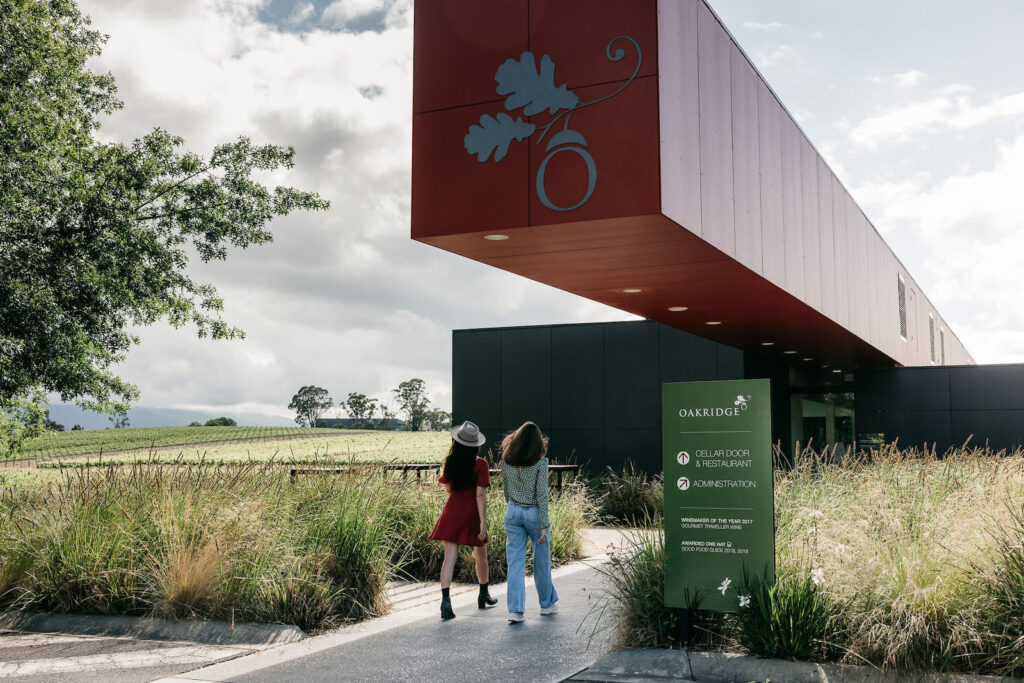
DB: But these wines they’re making now – Napa for example. You can argue that it is a logical extension of their blending program. They’ve been blending regions together here for ever, as part of Penfolds methodology, and they’ve just extended it into other countries. Being able to put together a Napa and French blend means they can sell it in China.
We have a house style with our whites, and that’s possibly why we’ve been successful. It’s fairly well articulated what it is, and that’s been of great benefit to us. When we look at the reds, it hasn’t been so clearly defined, and part of that is because we’ve moved around to a number of vineyards and haven’t been able to hold that conversation. Penfolds have been very good at that, and house style has been key to it. And blending to house style rather than anything else. Here’s a benchmark of quality and let’s push everything to get to that point. Whereas for us it is a bit more top down.
And we don’t control all of our vineyards, so the ongoing battle from growers is “Show me the Money!” The thing with being a big company – while the reaction hasn’t been as lightning fast as I would like, but it’s been reasonably good in that we now have three vineyards that we own – this one, Hazeldene and the original Oakridge Vineyard – Five Oaks. We lease Henk, Funder – which has been a staple Chardonnay for us for 13 years. It’s made 864 most years since 2011 – that’s a classification. Hyde Park we lease as well, and we’re on the hunt for another vineyard, and some bare land – a green field site.
WF: Ok – that’s exciting. Is there something that you’d like to do?
DB: There’s lots I’d like to do. There’s been lots of opportunities that have been lost. And that’s just the way it goes. Winning an award last week has given me the King’s ear! So all of a sudden I get a phone call from the CEO about various things, and what do we need? It’s pretty clear – here’s the list! It’s a bit of “Watch this space”. We’re good growers. There are six in the vineyard team – there’s two in the winery team. Because that’s where all the work needs to be done – we’re just stopping things from getting messed up.
For me, the whole genesis of it was when I came here, it was in a real state. And it was really about breaking it down. Nothing worked here. No equipment worked properly, but that allowed us to break it back to very simple methodology, and we’ll find out what the best bits are. We landed on technique that was entirely reproducible, whether it was a warm or a cool season. We had ideas about having grapes in certain places that would give us a certain result. Hot vineyards versus cool vineyards. And if we don’t need to do much in the way of amelioration. If that’s the case, we’re probably in the right spot.
So these Upper Yarra vineyards started coming in with good flavour, moderate sugars and good acidities. And there was a lack of logic in some winemaking because that’s what you got taught at University! To do stuff!
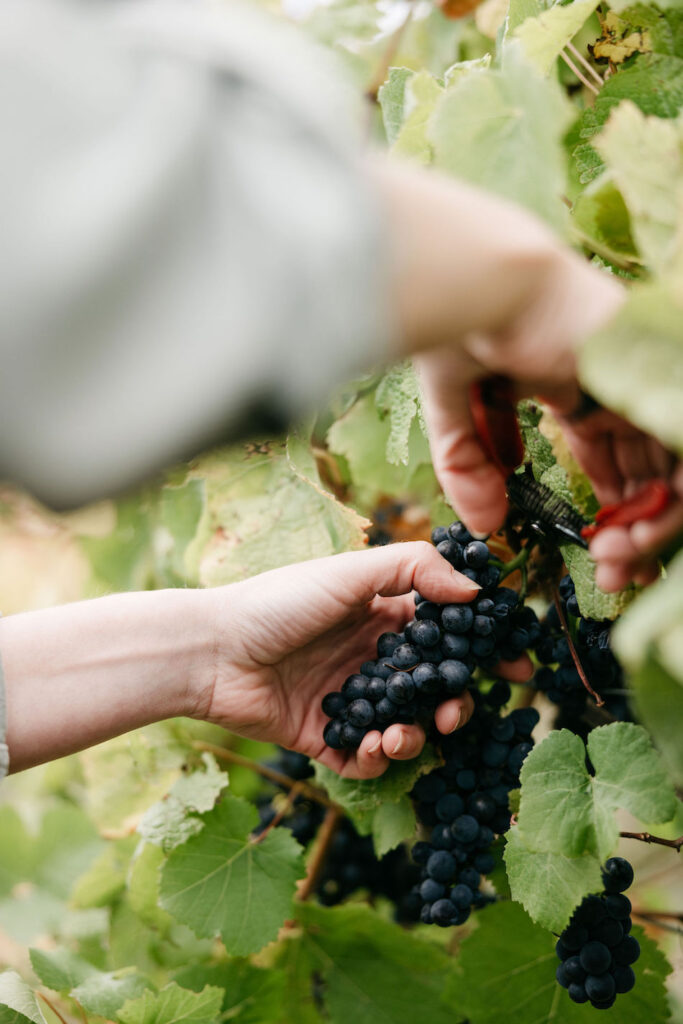
How about we do nothing?! And if we don’t actually have to touch it – the pH is great, the acidity is great, the flavour is great, it’s 13% alcohol. We’ll leave it on its lees for the rest of the year and see what happens.
When I started buying puncheons in 2003, I was the only person in Victoria buying puncheons. The only one. Every single place you go to now… I’ve still got puncheons I use now from 2004. We refer to them as wine coffins. That’s where wines go to die. But also, none of this is revolutionary. Although no-one was doing any of this stuff, it’s actually not hard! And the wines taste better.
WF: Is there anything that you wouldn’t do, if you look back on it?
DB: Yes, but not too many (laughs). There aren’t too many. A bit of work with reds that I would change. We were probably trying too hard. I am a fairly strong believer in red wine having tannin. And Pinot Noir should have tannin as well. Maybe I’m out of step with the fashion for lightness and bunches and fragrance – to a degree. So we worked a lot harder on trying to build structure in Pinot. And Yarra Cab, historically, was never more than medium-bodied. And we have worked them quite hard in the past to get as much out as possible. We possibly macerated them too long. Up to four to six weeks post-fermentation. If you see some of the twenty year old wines now, you’ll think they’re fantastic, but they certainly didn’t grab anyone’s attention when they were younger wines. We’ve brought that back a bit. Let the wines be a bit more expansive than as straight-jacketed as we are with our whites. I think that’s really had an effect.
We’ve also had a couple of good vintages! 2021 was difficult but we had really nice, dry, warm conditions at the back end – and, for Cab, it worked perfectly. 1995 was a vintage where it was really tricky right through March with Chardonnay and Pinot. We got into April and it was like a switch got hit, and we had monotonous weather for three and a half weeks – from 5 to 25 degrees and sunny every day. It was magic. Cab was clearly the best variety in 1995.
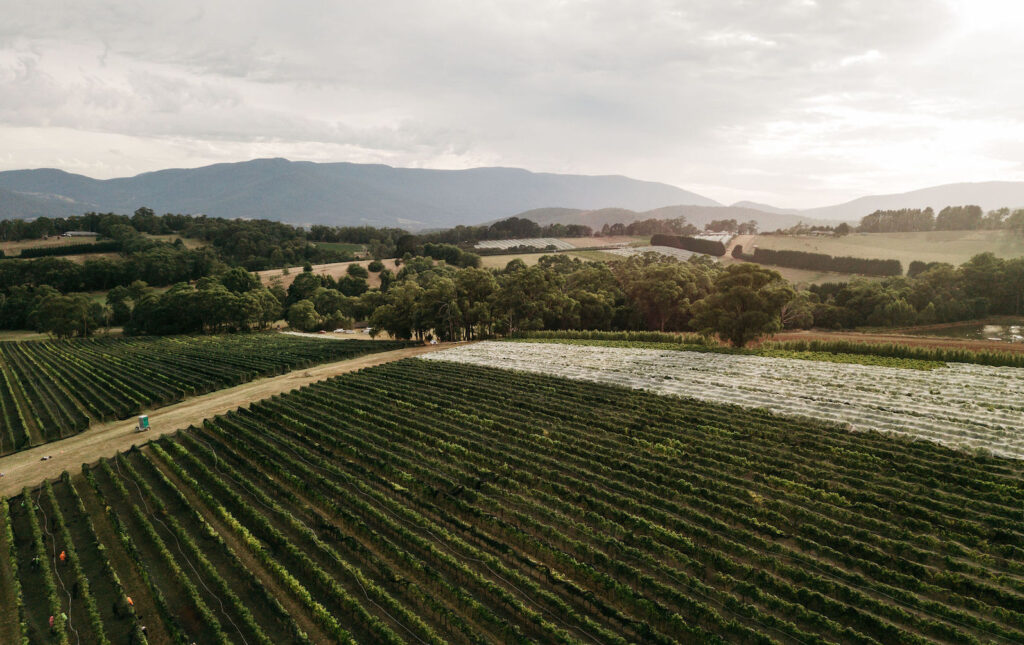
WF: Going back to that idea of ‘house style’ – is that partly down to a high solids style of fermentation, or is there more to it than that?
DB: That solids ferment character, the reduction – is part of Chardonnay’s DNA I reckon. Very turbid juice with a reasonable quantity of pressed material in there. You go to Burgundy and everything goes in – the works! We’ve taken a non-sparkling winemakers approach, which is like “550 litres per tonne – don’t go more than that, because it’s too phenolic!” We actually want a bit of al dente phenolic. We want the wines to have structure. We want them to be toothsome.
WF: “Toothsome” is a brilliant description!
DB: Those are the wines that are going to stand up at the table. They’ve got flavour and they’ve got texture, and they work with food. There’s three bits to the whole thing, when it works. It’s wine and there’s food and there’s people.
WF: Sometimes I’m the sad case who is sitting at home, reviewing, at 11 o’clock in the morning, trying to get a good sense of a wine – on my own, taking this tiny bit out of each bottle. It’s hard!
DB: I wrote for Halliday for two years. It was a nightmare – horrible. We were doing Vintage and I was trying to write – reviewing a hundred wines a day. And there’s so much work behind the logistics of it. There’s so many horrible wines.
We’re in a different part of the industry and we’re attempting to do something that’s different as well. Trying to make the absolute best thing we can. Whereas the greater part of the industry – it’s just a job. Grapes come in and they make it – there’s a set of numbers. Hit the numbers. Hit the numbers. Hit the numbers. Go home.
I haven’t had a day off since the end of January, because you’ve got to live it and breathe it, or you’re not part of it. And this is where the little companies have done well historically in this country – because they live and breathe it.
People also bring up the false comparison to Burgundy up all the time. We’re not trying to make Burgundy. We’re trying to make Australian-flavoured, Yarra Valley-flavoured, Oakridge-flavoured wine. If someone reckons they can taste – identify – our whites, then Hallelujah! That’s nailing the brief. Because then we are making an identity and it is reflecting that concept of terroir – the identity of where it is made.
It’s like the ‘mint thing’ in Australian circles. If there’s any mint, then winemakers lose their minds. Mint is the worst thing that could ever happen. My philosophy on that is “so what?” Eucalyptus is the native tree variety in this country. It’s part of the terroir of the place. Part of the taste of this land. You can get away with it in Shiraz it seems…but Pinot Noir you can’t! But people actually like mint. Why is toothpaste mint flavoured? They could pick any flavour they like. But they make it minty because people actually like it.
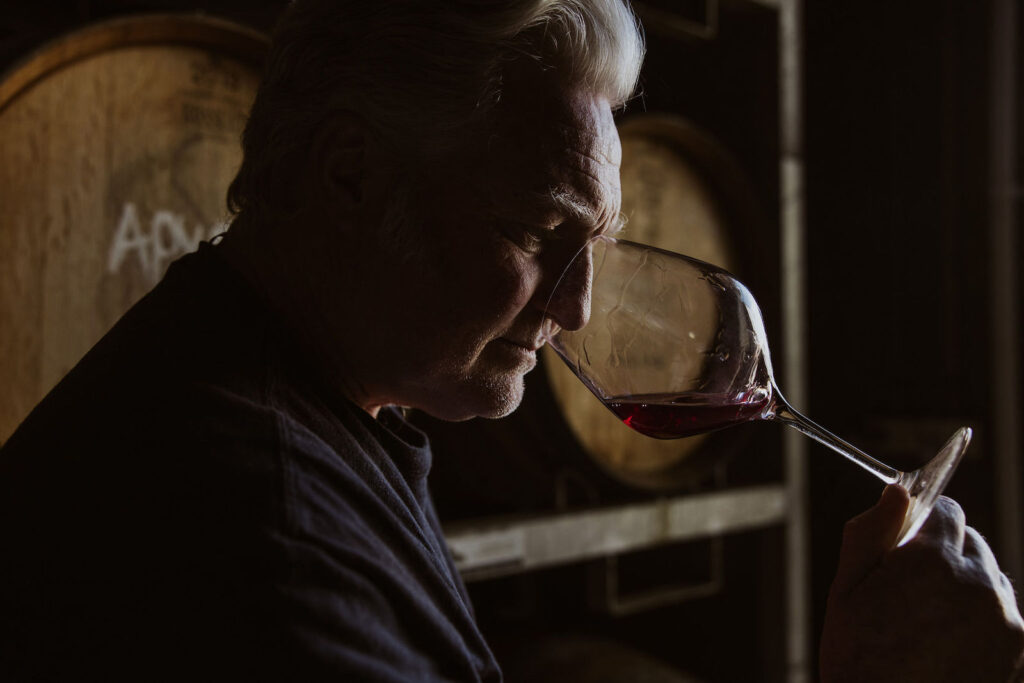
WF: You shouldn’t really be trying to hide anything? Why start looking to take stuff out? If it’s mint today, then it will be something else tomorrow.
DB: And in so many ways we just lucked into this! A number of things have happened. 15-20 years ago a lot of guys in the Upper Yarra were struggling to find a home for fruit, because all of those vineyards were planted for sparkling wine. Chandon were taking some and Accolade were taking a lot. There’s a certain vineyard up there that was recently sold, and Accolade have been trying to sell for a number of years – that Ed Carr rated as the best sparkling vineyard in mainland Australia. And yet pulled half of it out, and they weren’t really doing anything with it. All these vineyards that Accolade had for sparkling wine, and were being cropped at 15 tonnes to the hectare – watering the crap out of them.
Willow Lake is fifty years old next year, but had been abandoned by these bigger companies. I went up there and said “Well let’s crop it at this level, and this is how much I’ll pay you, and let’s go from there”. Funder was all going to sparkling wine. Henk was all going to sparkling wine. Willow Lake was going to sparkling wine. We brought it in and we made great table wine. Got on top of the growing regime – got the crops down. Ideally we’re looking at 6-7 tonnes, although we’re lucky to get four tonne in the last few years.
And we haven’t irrigated anything in four years. Irrigation is seen as a dirty word – seen as a bad thing, but it’s actually not. When you’re irrigating to try and get 15 tonnes per hectare, or thirty tonnes per hectare – commercial grape growing, then that’s bad. But water is just a part of the air conditioning for the vines. Because we’ve had a couple of those really fierce, hot seasons in the last ten years, we’ve learnt how to cope with that. We’ve been gearing towards those hotter seasons rather than cooler, wetter seasons, which has caught everyone out a bit.
Back in 2007 we’d had ten years of drought, with almost every month with rainfall below long-term averages. The dam down here in 2009 was empty. It holds three years of water for this vineyard. And it was empty. We managed to pump water out of the river – 6kms up here – after it rained for the first time in eight weeks, and kept part of the vineyard alive. So that water kept the leaves functioning. Irrigation in those hot years is essential. It can change really quickly.
Another thing we are doing is trying to pick the best out of the vineyards – picking in bands and picking a vineyard in, say, three sections. Over twenty-odd years we’ve walked the vineyards and looking at it. In recent years we’ve done infra-red and aerial work as well, which has basically reinforced what we thought.
WF: Are you a fan of whole bunch in your reds?
DB: Yes. (hesitates) I reckon it has been better in a lot of ways, longer term, in our Syrahs rather than Pinot. Particularly with a vineyard like Willow Lake where we’re focused on purity of fruit rather than winemaking artefact. So a lot of de-stemming with that. More recently we have been using about 20% whole bunch with Henk.
And again, it’s about having it there but it’s not overwhelming. When I lost my vineyard, I managed to get hold of some Shiraz from a local grower, and fermented that 100% whole bunch, but it reached a stage where it was getting too thin and stalky. It was about halfway through fermentation, and I shovelled it out and put it through the de-stemmer, and put it back in.
Ideally, even with Pinot, we’re fermenting everything with 14 days on skins, and some years much longer than that. We hand pack everything and put it in the cool room overnight and deal with it the next day. It gives us control over what we’re doing. We’ve moved over to optically sorting now this year, as well as the new de-stemmer we got last year. A couple of bits of modern equipment are changing the style of our wines slightly.
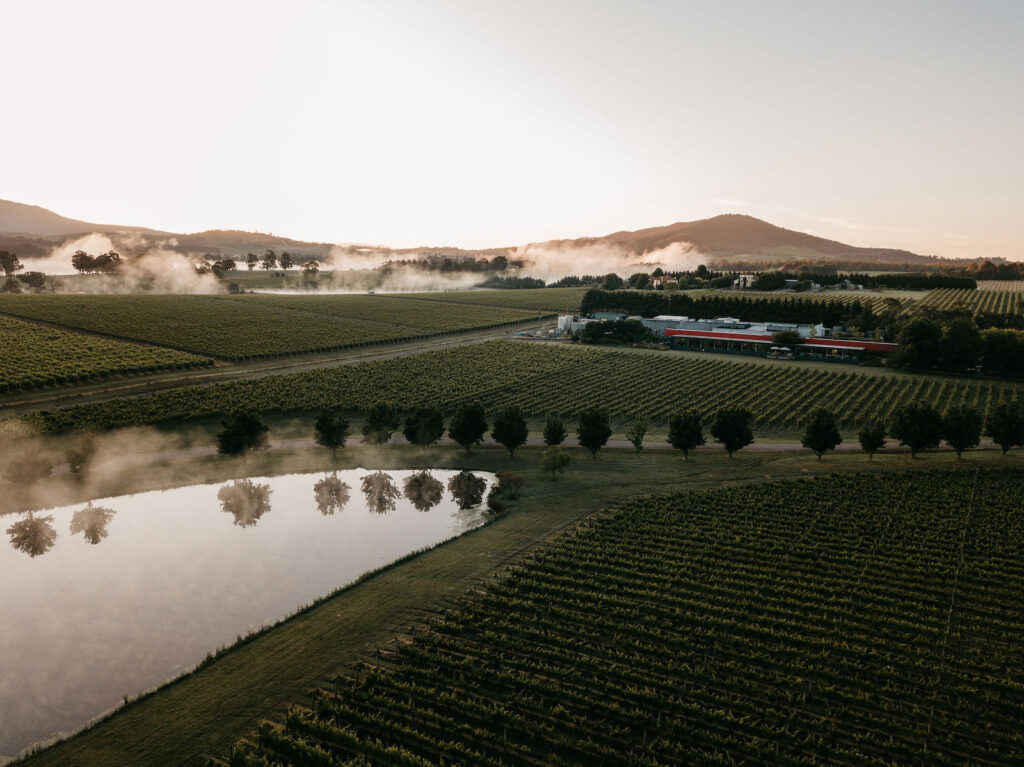
The vineyard wines are the driver in the market for us. The acceptance of tannic Pinot Noir is generally with people, I suppose, who drink Burgundy. When you taste 864 Pinot, there’s a lot more structure and firmness to it, because, if you like, it’s much more of that Grand Cru model, where it is built for the long haul.
WF: What wines do you like to drink?
DB: I drink a lot of Beaujolais. I worked in Beaujolais in 1995 and really loved the wines, because they’ve got that style and substance about them – Cru Beaujolais. And they are affordable as well. One particular producer – Daniel Bouland – I buy boxes and boxes every year. And we probably drink more Pinot at home than anything else.
One thing that we’re doing here – is it’s a giant scientific experiment where we get to test it on the human population. Legally. If we can break the techniques down and take all of those variables out, then we stand to actually learn something. Funder is a really good example, where it is three blocks of Chardonnay, and are quite different. When you taste the wine, and walk around the vineyard and see the plants and how they’re growing, it all makes sense. And that’s all we’ve been trying to do. Make sense of it all.

